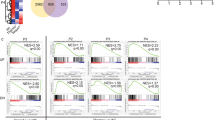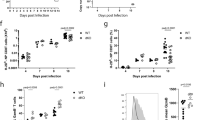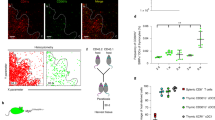Abstract
Passage through the β-selection developmental checkpoint requires productive rearrangement of segments of the T cell antigen receptor-β gene (Tcrb) and formation of a pre-TCR on the surface of CD4−CD8− thymocytes. How other receptors influence ββ-selection is less well understood. Here we define a new role for the chemokine receptor CXCR4 during T cell development. CXCR4 functionally associated with the pre-TCR and influenced β-selection by regulating the steady-state localization of immature thymocytes in thymic subregions, by facilitating optimal pre-TCR-induced survival signals, and by promoting thymocyte proliferation. We also characterize functionally relevant signaling molecules downstream of CXCR4 and the pre-TCR in thymocytes. Our data designate CXCR4 as a costimulator of the pre-TCR during β-selection.
This is a preview of subscription content, access via your institution
Access options
Subscribe to this journal
Receive 12 print issues and online access
$209.00 per year
only $17.42 per issue
Buy this article
- Purchase on Springer Link
- Instant access to full article PDF
Prices may be subject to local taxes which are calculated during checkout







Similar content being viewed by others
References
Kruisbeek, A.M. et al. Branching out to gain control: how the pre-TCR is linked to multiple functions. Immunol. Today 21, 637–644 (2000).
Wiest, D.L., Berger, M.A. & Carleton, M. Control of early thymocyte development by the pre-T cell receptor complex: A receptor without a ligand? Semin. Immunol. 11, 251–262 (1999).
von Boehmer, H. Unique features of the pre-T-cell receptor α-chain: not just a surrogate. Nat. Rev. Immunol. 5, 571–577 (2005).
Petrie, H.T. & Zúñiga-Pflücker, J.C. Zoned out: functional mapping of stromal signaling microenvironments in the thymus. Annu. Rev. Immunol. 25, 649–679 (2007).
Hollander, G. et al. Cellular and molecular events during early thymus development. Immunol. Rev. 209, 28–46 (2006).
Takahama, Y. Journey through the thymus: stromal guides for T-cell development and selection. Nat. Rev. Immunol. 6, 127–135 (2006).
Zou, Y.R., Kottmann, A.H., Kuroda, M., Taniuchi, I. & Littman, D.R. Function of the chemokine receptor CXCR4 in haematopoiesis and in cerebellar development. Nature 393, 595–599 (1998).
Nagasawa, T. et al. Defects of B-cell lymphopoiesis and bone-marrow myelopoiesis in mice lacking the CXC chemokine PBSF/SDF-1. Nature 382, 635–638 (1996).
Tachibana, K. et al. The chemokine receptor CXCR4 is essential for vascularization of the gastrointestinal tract. Nature 393, 591–594 (1998).
Ceradini, D.J. et al. Progenitor cell trafficking is regulated by hypoxic gradients through HIF-1 induction of SDF-1. Nat. Med. 10, 858–864 (2004).
Okada, T. et al. Chemokine requirements for B cell entry to lymph nodes and Peyer′s patches. J. Exp. Med. 196, 65–75 (2002).
Feng, Y., Broder, C.C., Kennedy, P.E. & Berger, E.A. HIV-1 entry cofactor: functional cDNA cloning of a seven-transmembrane, G protein-coupled receptor. Science 272, 872–877 (1996).
Poznansky, M.C. et al. Active movement of T cells away from a chemokine. Nat. Med. 6, 543–548 (2000).
Cyster, J.G. Chemorepulsion and thymocyte emigration. J. Clin. Invest. 109, 1011–1012 (2002).
Kumar, A. et al. CXCR4 physically associates with the T cell receptor to signal in T cells. Immunity 25, 213–224 (2006).
Molon, B. et al. T cell costimulation by chemokine receptors. Nat. Immunol. 6, 465–471 (2005).
Plotkin, J., Prockop, S.E., Lepique, A. & Petrie, H.T. Critical role for CXCR4 signaling in progenitor localization and T cell differentiation in the postnatal thymus. J. Immunol. 171, 4521–4527 (2003).
Aifantis, I., Mandal, M., Sawai, K., Ferrando, A. & Vilimas, T. Regulation of T-cell progenitor survival and cell-cycle entry by the pre-T-cell receptor. Immunol. Rev. 209, 159–169 (2006).
Ciofani, M. & Zúñiga-Pflücker, J.C. The thymus as an inductive site for T lymphopoiesis. Annu. Rev. Cell Dev. Biol. 23, 463–493 (2007).
Ciofani, M. et al. Obligatory role for cooperative signaling by pre-TCR and Notch during thymocyte differentiation. J. Immunol. 172, 5230–5239 (2004).
Haks, M.C., Krimpenfort, P., van den Brakel, J.H. & Kruisbeek, A.M. Pre-TCR signaling and inactivation of p53 induces crucial cell survival pathways in pre-T cells. Immunity 11, 91–101 (1999).
Opferman, J.T. & Korsmeyer, S.J. Apoptosis in the development and maintenance of the immune system. Nat. Immunol. 4, 410–415 (2003).
Voll, R.E. et al. NF-κB activation by the pre-T cell receptor serves as a selective survival signal in T lymphocyte development. Immunity 13, 677–689 (2000).
Mandal, M. et al. The BCL2A1 gene as a pre-T cell receptor-induced regulator of thymocyte survival. J. Exp. Med. 201, 603–614 (2005).
Lind, E.F., Prockop, S.E., Porritt, H.E. & Petrie, H.T. Mapping precursor movement through the postnatal thymus reveals specific microenvironments supporting defined stages of early lymphoid development. J. Exp. Med. 194, 127–134 (2001).
Sierro, F. et al. Disrupted cardiac development but normal hematopoiesis in mice deficient in the second CXCL12/SDF-1 receptor, CXCR7. Proc. Natl. Acad. Sci. USA 104, 14759–14764 (2007).
Schols, D. et al. Inhibition of T-tropic HIV strains by selective antagonization of the chemokine receptor CXCR4. J. Exp. Med. 186, 1383–1388 (1997).
Nie, Y. et al. The role of CXCR4 in maintaining peripheral B cell compartments and humoral immunity. J. Exp. Med. 200, 1145–1156 (2004).
Lee, P.P. et al. A critical role for Dnmt1 and DNA methylation in T cell development, function, and survival. Immunity 15, 763–774 (2001).
Kabashima, K. et al. CXCR4 engagement promotes dendritic cell survival and maturation. Biochem. Biophys. Res. Commun. 361, 1012–1016 (2007).
Suzuki, Y., Rahman, M. & Mitsuya, H. Diverse transcriptional response of CD4+ T cells to stromal cell-derived factor (SDF)-1: cell survival promotion and priming effects of SDF-1 on CD4+ T cells. J. Immunol. 167, 3064–3073 (2001).
Schmitt, T.M. & Zúñiga-Pflücker, J.C. Induction of T cell development from hematopoietic progenitor cells by delta-like-1 in vitro. Immunity 17, 749–756 (2002).
Ciofani, M. & Zúñiga-Pflücker, J.C. A survival guide to early T cell development. Immunol. Res. 34, 117–132 (2006).
Yang, L. et al. Blocking CXCR4-mediated cyclic AMP suppression inhibits brain tumor growth in vivo. Cancer Res. 67, 651–658 (2007).
Shinkai, Y. et al. RAG-2-deficient mice lack mature lymphocytes owing to inability to initiate V(D)J rearrangement. Cell 68, 855–867 (1992).
Shinkai, Y. et al. Restoration of T cell development in RAG-2-deficient mice by functional TCR transgenes. Science 259, 822–825 (1993).
Aifantis, I., Gounari, F., Scorrano, L., Borowski, C. & von Boehmer, H. Constitutive pre-TCR signaling promotes differentiation through Ca2+ mobilization and activation of NF-κB and NFAT. Nat. Immunol. 2, 403–409 (2001).
Trautmann, A. Chemokines as immunotransmitters? Nat. Immunol. 6, 427–428 (2005).
Sotsios, Y., Whittaker, G.C., Westwick, J. & Ward, S.G. The CXC chemokine stromal cell-derived factor activates a Gi-coupled phosphoinositide 3-kinase in T lymphocytes. J. Immunol. 163, 5954–5963 (1999).
Kelemen, B.R., Hsiao, K. & Goueli, S.A. Selective in vivo inhibition of mitogen-activated protein kinase activation using cell-permeable peptides. J. Biol. Chem. 277, 8741–8748 (2002).
Alsayed, Y. et al. Mechanisms of regulation of CXCR4/SDF-1 (CXCL12)-dependent migration and homing in multiple myeloma. Blood 109, 2708–2717 (2007).
Kremer, K.N., Humphreys, T.D., Kumar, A., Qian, N.X. & Hedin, K.E. Distinct role of ZAP-70 and Src homology 2 domain-containing leukocyte protein of 76 kDa in the prolonged activation of extracellular signal-regulated protein kinase by the stromal cell-derived factor-1α/CXCL12 chemokine. J. Immunol. 171, 360–367 (2003).
Trampont, P., Zhang, L. & Ravichandran, K.S. ShcA mediates the dominant pathway to extracellular signal-regulated kinase activation during early thymic development. Mol. Cell. Biol. 26, 9035–9044 (2006).
Zhang, L., Camerini, V., Bender, T.P. & Ravichandran, K.S. A nonredundant role for the adapter protein Shc in thymic T cell development. Nat. Immunol. 3, 749–755 (2002).
Patrussi, L. et al. p52Shc is required for CXCR4-dependent signaling and chemotaxis in T cells. Blood 110, 1730–1738 (2007).
von Boehmer, H. et al. Crucial function of the pre-T-cell receptor (TCR) in TCR beta selection, TCR beta allelic exclusion and αβ versus γδ lineage commitment. Immunol. Rev. 165, 111–119 (1998).
Espert, L. et al. Autophagy is involved in T cell death after binding of HIV-1 envelope proteins to CXCR4. J. Clin. Invest. 116, 2161–2172 (2006).
Brooks, D.G., Kitchen, S.G., Kitchen, C.M., Scripture-Adams, D.D. & Zack, J.A. Generation of HIV latency during thymopoiesis. Nat. Med. 7, 459–464 (2001).
Yoder, A. et al. HIV envelope-CXCR4 signaling activates cofilin to overcome cortical actin restriction in resting CD4 T cells. Cell 134, 782–792 (2008).
Broxmeyer, H.E. et al. Transgenic expression of stromal cell-derived factor-1/CXC chemokine ligand 12 enhances myeloid progenitor cell survival/antiapoptosis in vitro in response to growth factor withdrawal and enhances myelopoiesis in vivo. J. Immunol. 170, 421–429 (2003).
Acknowledgements
We thank J.C. Zúñiga-Pflücker (Sunnybrook Research Institute, University of Toronto) for OP9-DL1 cells; I. Aifantis (New York University School of Medicine) for SCIET27 and SCB29 cells; the flow cytometry and histology core facilities at the University of Virginia for technical assistance; members of the Ravichandran laboratory and specifically I.J. Juncadella and M.R. Elliott for technical assistance; and J. Lysiak and R. Woodson for help with the Apostain technique. Supported by the National Institute of General Medical Sciences (K.S.R.), the National Cancer Institute (T.P.B.) and the Howard Hughes Medical Institute (D.R.L.).
Author information
Authors and Affiliations
Contributions
P.C.T. designed and did the experiments and wrote the manuscript; A.-C.T.-T. did the experiments for Figures 6a,c,e,f and 7a,b and helped with the manuscript; A.K.D. provided the Rag2−/− and Rag2−/− TCRβ+ mice and provided assistance for Figure 3a; Y.S. provided the data in Figure 1b; T.B.P. and A.E.S. provided access to mouse strains and reagents; D.R.L. shared unpublished information and provided the floxed Cxcr4 mouse strain and intellectual input; and K.S.R. supervised the overall design, the conduct and interpretation of the experiments, and the writing of the manuscript.
Corresponding author
Supplementary information
Supplementary Text and Figures
Supplementary Figures 1–9 and Supplementary Table 1 (PDF 856 kb)
Rights and permissions
About this article
Cite this article
Trampont, P., Tosello-Trampont, AC., Shen, Y. et al. CXCR4 acts as a costimulator during thymic β-selection. Nat Immunol 11, 162–170 (2010). https://doi.org/10.1038/ni.1830
Received:
Accepted:
Published:
Issue Date:
DOI: https://doi.org/10.1038/ni.1830
This article is cited by
-
The significance of the SDF-1/CXCR4 signaling pathway in the normal development
Molecular Biology Reports (2022)
-
A clinically applicable and scalable method to regenerate T-cells from iPSCs for off-the-shelf T-cell immunotherapy
Nature Communications (2021)
-
TREC Screening for WHIM Syndrome
Journal of Clinical Immunology (2021)
-
CXCR4 signaling directs Igk recombination and the molecular mechanisms of late B lymphopoiesis
Nature Immunology (2019)
-
WHIM Syndrome: from Pathogenesis Towards Personalized Medicine and Cure
Journal of Clinical Immunology (2019)



